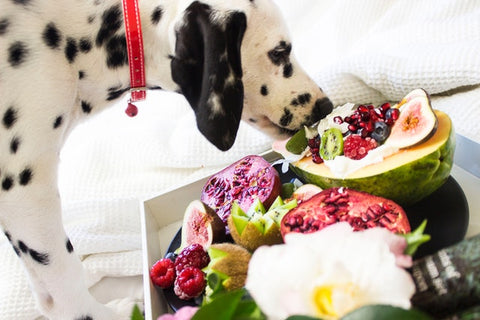Shopping Cart ( )
Your cart is currently empty.
Starting your dogs on a raw food diet is a fantastic decision seeing as you'll be bettering their health and giving them a nutritious meal that they'll like. But how do you switch to a new diet smoothly while prioritising your dog’s well-being? Let’s take a look at this together.

The best way to convert your dog from eating dry or wet food to a raw diet for the first time is to do it gradually over a period of 7-10 days. This allows you to gently introduce it to your dog so that its digestive system is not disrupted.
Nevertheless, there are two ways in which you can transition your dog to a raw meal:
This method is the most straightforward. Simply cease feeding the old food and feed the raw dog food at the next meal.
Only young canines or those with a healthy gastrointestinal system should use the quick changeover approach.
Any abrupt dietary changes might cause stomach distress in some dogs; however, these concerns should subside within a few days as your pet adjusts to the new diet.
This approach is a gradual shift that might take anywhere from 1 to 4 weeks. The speed at which this happens will be determined by your dog's reaction to the meal.
Over a few days, gradually reduce your dog’s usual food while increasing the amount of raw food until your pet's diet is entirely raw.
If your dog is experiencing loose stools early on in the process, reduce the amount of raw food you're feeding and gradually increase it.
The end outcome should be a slight, firm stool consistency as a result of improved nutrition absorption.
You might be able to speed up the procedure if your dogs adapt effectively. For example, if they are experiencing symptoms like an upset stomach, you might want to take things a little slower and introduce smaller amounts of raw food over a more extended period.

Here are some symptoms your dog might experience when you start a raw diet:
Don’t be worried if you observe some or all of these things occurring to your pet at first. This just shows that your dog’s body is trying to get used to this new diet.
However, it is critical to seek the assistance of your veterinarian if these detoxification symptoms continue or worsen.
Your dog's raw dog food requirements will be determined by several factors, including their age, breed, and lifestyle.
An adult dog should consume about 2-4% of its optimum body weight each day as a general guideline. For instance, a dog who is 10kg should consume roughly 200g of raw food daily.
Puppies need roughly 5-8 % of their body weight each day, spread out across 3-4 meals, starting at the age of 8 weeks.
Moreover, you can always add raw eggs, vegetables and even fruits into your dog’s raw diet. This will give your dog additional nutrients that it can't get from the protein source.
For example, you can start by including sweet potatoes into your dog’s diet as this vegetable is an excellent source of Vitamin A. This will boost your canine’s skin and coat health.
Learn more about how much raw food you have to feed your dog to reap the benefits of raw feeding.
Some dogs just need the extra push when it’s starting something new. So here are some suggestions for successfully switching your dog to a raw diet.
Firstly, if you offer the food in a deep dish, it may be difficult for certain dogs to see what you're serving them. So place the uncooked food on a shallow plate instead to show your dog that they have nothing to be concerned about.
Next, you can allow the meal to rest at room temperature for 30 minutes before feeding to improve its appeal. This will also enhance the food's fragrance. Even if the food smells good, your canine might be sceptical about it at first, so doing this will help decrease its anxiety when trying something new.
You should be aware that the raw diet will come as a little shock to your dog's system, regardless of how you introduce it. Hence, for at least the first week, use only one type of protein in your dog's meals.
You may introduce the next source of meat after your dog has been accustomed to the first, giving him at least a week to acclimatise. Then, after a few months of following a raw diet, you may start experimenting and find out which is the best raw food for your dog.
If you realise that your dog’s stool is a bit runnier than usual, fear not. This is a textbook case of detoxification. From the inside out, the body is mending itself.
These symptoms will go away after the detoxification process is completed, and your pet will be healthier and happier as a result. If your pet is relatively healthy, the symptoms should last no more than two weeks.
No, a raw diet will not harm your dog. This diet can only hurt your dog if you do not follow proper guidelines when preparing the meal.
There have been instances where bacteria can spread from raw meat to your dog or yourself if it is not cleaned well. Many who are beginners to feeding raw dog food struggle to get a grasp of this part.
Hence, due to the complications of accurately learning how to safely handle raw dog food, pet parents prefer to buy pre-made raw meals.
You can try out Petcubes’ Raw Dog Food, which has multiple options you can choose from. Our diets are made carefully by professionals and are guaranteed to improve your dog’s health. It is also super easy to make!
It's vital to understand that transitioning to a raw diet may be difficult if not done carefully. We advocate doing so gently and gradually for your pet’s sake.
Dr Francis is one of the top wildlife nutritionists in Asia. Originating from Montreal, Canada, he left at 21 to pursue his Masters and subsequently a PhD in wildlife nutrition at Oxford Brookes University. Instead of taking the path of common animal science to learn about farm animals, or through the veterinarian space and taking a certificate in nutrition, he took the road less travelled to dive deep into the world of animal ecology, metabolism and nutrition.
You have no items in wishlist.
| Title |
|---|
| Price |
| Add to cart |
| Type |
| Vendor |
| Title |
|---|
| Price |
| Add to cart |
| Type |
| Vendor |

